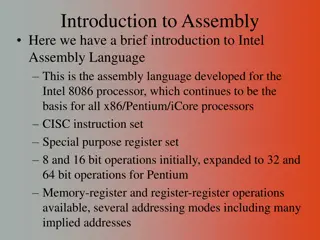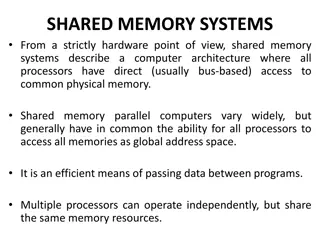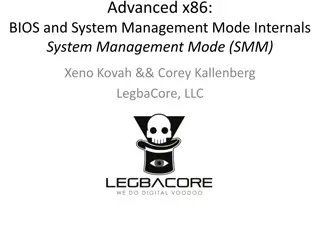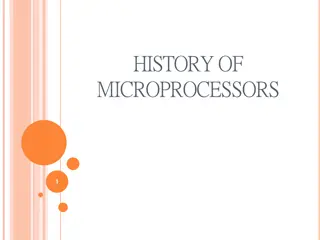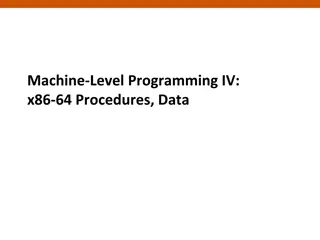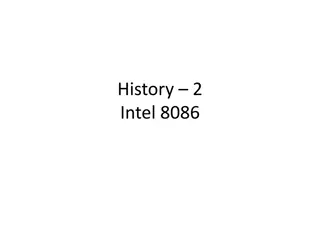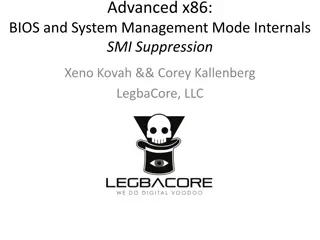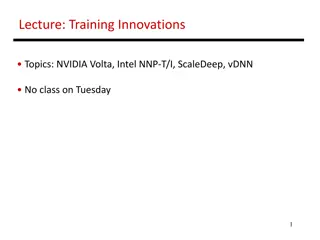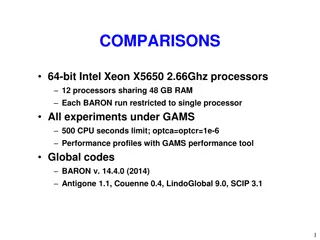Evolution of Intel x86 Processors
Intel's x86 processor series began with the 8086 in 1982 and evolved through the 80186, 80286, 386DX, 386SX, and 386EX models, each offering advancements in performance, addressing, and data capabilities. These processors played a pivotal role in the development of desktop computing, with features such as multitasking support, memory protection, and increased data bus widths. The evolution from 16-bit to 32-bit architectures marked significant progress in the x86 processor lineage.
Download Presentation

Please find below an Image/Link to download the presentation.
The content on the website is provided AS IS for your information and personal use only. It may not be sold, licensed, or shared on other websites without obtaining consent from the author.If you encounter any issues during the download, it is possible that the publisher has removed the file from their server.
You are allowed to download the files provided on this website for personal or commercial use, subject to the condition that they are used lawfully. All files are the property of their respective owners.
The content on the website is provided AS IS for your information and personal use only. It may not be sold, licensed, or shared on other websites without obtaining consent from the author.
E N D
Presentation Transcript
80186 Intel 80186 is a microprocessor and microcontroller introduced in 1982. It was based on the Intel 8086, & like it, had a 16-bit external data bus multiplexed with a 20-bit address bus.
68 pins 29,000 transistors ~ as an embedded version of 8086. Added 7 new instructions: push all, pop all, etc. 1982 ~ Sept. 2007.
80286 / iAPX 286 February 1, 1982 Bus Width: 16 bits data, 24 bits address. Included memory protection hardware to support multitasking operating systems with per-process address space Number of Transistors 134,000 Addressable memory 16 MB 3~6X the performance of the 8086
4 independent units: address unit, bus unit, instruction unit and execution unit, which formed a pipeline significantly increasing the performance. In computing, a pipeline is a set of data processing elements connected in series, so that the output of one element is the input of the next one. The elements of a pipeline are often executed in parallel or in time-sliced fashion; in that case, some amount of buffer storage is often inserted between elements.
386DX Introduced October 17, 1985 Bus Width 32 bits data, 32 bits address Number of Transistors 275,000 Addressable memory 4 GB Virtual Memory 64 TB First x86 chip to handle 32-bit data sets Used in desktop computing
386SX June 16, 1988 a low cost version of the 80386 with a 16-bit data bus. The original 80386 was subsequently renamed i386DX to avoid confusion. However, Intel subsequently used the 'DX' suffix to refer to the floating-point capability of the i486DX.
386EX Introduced August 1994 Variant of 80386SX intended for embedded systems Static core, i.e., may run as slowly (and thus, power efficiently) as desired, down to full halt Static core is a CPU chip that can be stopped simply by stopping the system clock oscillator that is driving it, and it will hold its state indefinitely and resume processing at the point it was stopped when the clock signal is restarted, as long as it is kept powered. It allows the use of less power, and is suitable for standby mode.
On-chip peripherals: Clock and power management Timers/counters Watchdog timer Serial I/O units (sync and async) and parallel I/O DMA RAM refresh Used aboard several orbiting satellites and microsatellites Used in NASA's FlightLinux project
Watchdog regulator - supervisory body A watchdog timer (or computer operating properly (COP) timer) is a computer hardware or software timer that triggers a system reset or other corrective action, if the main program [due to some fault condition, e.g., a hang] neglects to regularly service the watchdog by writing a "service pulse" to it (aka, "kicking the dog", petting the dog , "feeding the watchdog or "waking the watchdog"). The intention is to bring the system back: from an unresponsive state into normal operation.
DMA Direct memory access (DMA) is a feature of modern computers that allows certain hardware subsystems within the computer to access system memory independently of the CPU! Without DMA, when the CPU is using programmed input/output, it is typically fully occupied for the entire duration of the read or write operation, and is thus unavailable to perform other work. With DMA, the CPU initiates the transfer, does other operations while the transfer is in progress, and receives an interrupt from the DMA controller when the operation is done.
This feature is useful any time the CPU cannot keep up with the rate of data transfer, or where the CPU needs to perform useful work while waiting for a relatively slow I/O data transfer. Many hardware systems use DMA, including disk drive controllers, graphics cards, network cards and sound cards. DMA is also used for intra-chip data transfer in multi-core processors. Computers that have DMA channels can transfer data to and from devices with much less CPU overhead than computers without a DMA channel. Similarly, a processing element inside a multi-core processor can transfer data to and from its local memory without occupying its processor time, allowing computation and data transfer to proceed in parallel.
i386SL The i386SL was introduced as a power efficient version for laptop computers. The processor offered several power management options (e.g., SMM System Management Mode), as well as different "sleep" modes to conserve battery power. It also contained support for an external cache of 16 to 64 kB. The extra functions and circuit implementation techniques caused this variant to have over 3 times as many transistors as the i386DX.
SMM The system management mode - is an operating mode in which all normal execution (including the operating system) is suspended, and special separate software (usually firmware or a hardware-assisted debugger) is executed in high- privilege mode. It is intended for use only by system firmware, not by applications software or general-purpose systems software.
The first company to design and manufacture a PC based on the Intel 80386 was Compaq the 1st3rd-party to implement a major technical hardware advance on the PC platform. The 80486 and P5 Pentium line of processors were descendants of the 80386 design.
..486DX April 89 Bus width 32 bits No. of transistors 1.2 million Addressable memory 4 GB Virtual memory 1 TB Level 1 cache of 8 KB on chip Math coprocessor on chip 50X performance of the 8088 Used in Desktop computing and servers
..486SX April 91 Identical in design to 486DX but without math coprocessor. Used in low-cost entry to 486 CPU desktop computing, as well as extensively used in low cost mobile computing.
32-bit processors: P5 micro-architecture
Pentium Bus width 64 bits Address bus 32 bits Addressable Memory 4 GB Virtual Memory 64 TB Superscalar architecture Used in desktops 8 KB of instruction cache 8 KB of data cache
P5 Mar 93 3.1 mil transistors P54 3.2 mil tran.
Pentium with MMX tech. Jan. 97 Intel MMX (instruction set) support 16 KB L1 instruction cache 16 KB L1 data cache Number of transistors 4.5 million System bus clock rate 66 MHz
Variants 166, 200 MHz Introduced January 8, 1997 233 MHz Introduced June 2, 1997 133 MHz (Mobile) 166, 266 MHz (Mobile) Introduced January 12, 1998 200, 233 MHz (Mobile) Introduced September 8, 1997 300 MHz (Mobile) Introduced January 7, 1999
32-bit processors: P6/Pentium M microarchitecture
Pentium Pro Nov. 95 Precursor to Pentium II and III Primarily used in server systems 5.5 mil trans. 16 KB L1 cache 256 KB integrated L2 cache 60 MHz system bus clock rate
Pentium II May 7, 1997 Pentium Pro with MMX and improved 16-bit performance 242-pin processor package Number of transistors 7.5 million 32 KB L1 cache 512 KB bandwidth external L2 cache The only Pentium II that did not have the L2 cache at bandwidth of the core was the Pentium II 450 PE.
Celeron [Pentium II-based] Introduced April 15, 1998 242-pin SEPP (Single Edge Processor Package) Number of transistors 7.5 million 66 MHz system bus clock rate 32 KB L1 cache No L2 cache Variants 266 MHz Introduced April 15, 1998 300 MHz Introduced June 9, 1998
Pentium III Feb. 99 Improved PII, i.e., P6-based core, now including Streaming SIMD Extensions (SSE) Number of transistors 9.5 million 512 KB bandwidth L2 External cache 242-pin SECC2 (Single Edge Contact cartridge 2) processor package System Bus clock rate 100 MHz, 133 MHz (B- models)
Celeron (Pentium III Coppermine- based) Mar. 2000 28.1 mil trans. 66 MHz system bus clock rate, 100 MHz system bus clock rate from January 3, 2001 32 kB L1 cache 128 kB Advanced Transfer L2 cache
Pentium 4 Introduced April 2000 July 2002
Celeron (Pentium III Tualatin-based) 32 KB L1 cache 256 KB Advanced Transfer L2 cache 100 MHz system bus clock rate Family 6 model 11 Variants 1.0 GHz 1.1 GHz 1.2 GHz 1.3 GHz 1.4 GHz
Pentium M Mar. 2003 64 KB L1 cache 1 MB L2 cache (integrated) Based on Pentium III core, with SSE2 SIMD instructions and deeper pipeline Number of transistors 77 million Heart of the Intel mobile Centrino system
Variants 900 MHz (ultra low voltage) 1.0 GHz (ultra low voltage) 1.1 GHz (low voltage) 1.2 GHz (low voltage) 1.3 GHz 1.4 GHz 1.5 GHz 1.6 GHz 1.7 GHz 2.1 GHz
Celeron M Mar. 2003 64 KB L1 cache 512 KB L2 cache (integrated) SSE2 SIMD instructions No SpeedStep technology, is not part of the 'Centrino package
Intel Core Jan. 2006 Intel Core Duo T2700 2.33 GHz Intel Core Duo T2600 2.16 GHz Intel Core Duo T2500 2 GHz Intel Core Duo T2450 2 GHz Intel Core Duo T2400 1.83 GHz Intel Core Duo T2300 1.66 GHz Intel Core Duo T2050 1.6 GHz Intel Core Duo T2300e 1.66 GHz Intel Core Duo T2080 1.73 GHz Intel Core Duo L2500 1.83 GHz (low voltage, 15W TDP) Intel Core Duo L2400 1.66 GHz (low voltage, 15W TDP) Intel Core Duo L2300 1.5 GHz (low voltage, 15W TDP) Intel Core Duo U2500 1.2 GHz (ultra low voltage, 9W TDP) Intel Core Solo T1350 1.86 GHz (533 FSB) Intel Core Solo T1300 1.66 GHz Intel Core Solo T1200 1.5 GHz



